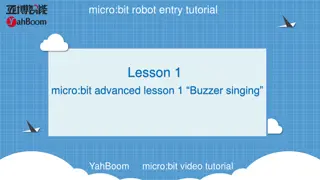
Implementing Simplest Version of Gomoku Game
"Learn how to implement the simplest version of the Gomoku game, a strategic board game, covering basic rules and game loop in Java."
Download Presentation

Please find below an Image/Link to download the presentation.
The content on the website is provided AS IS for your information and personal use only. It may not be sold, licensed, or shared on other websites without obtaining consent from the author. If you encounter any issues during the download, it is possible that the publisher has removed the file from their server.
You are allowed to download the files provided on this website for personal or commercial use, subject to the condition that they are used lawfully. All files are the property of their respective owners.
The content on the website is provided AS IS for your information and personal use only. It may not be sold, licensed, or shared on other websites without obtaining consent from the author.
E N D
Presentation Transcript
CSC1004 Tutorial 5 Yan Ke
An intro to games An example of
Gomoku Game Game Over 15 15 Chess Board A Draw (No One Wins) One Player Wins (Black in This Example) (e.g. we suppose the board is scaled down to be 5 5) Horizontally All positions for stones (chess) are taken without reaching the winning condition. Black Plays First No Overlap Player 1, place first vertically Already Placed It s not allowed to place a stone on some existing stone. Player 2, place later Five stones in a line Gomo (Also, it s not allowed to place any stone If the game is over) diagonally (and the stones should be placed on the intersection of the lines of the board)
Simplest Version: Iteration 1 Question 1: If you are required to implement a simplest version of Gomoku Game, how would you implement it? Potential Answer: I shall cover the basic game rules with console/terminal input and output as the game interface.
Simplest Version: Iteration 1 Class GomokuGame The main() function of Main class holds one instance Constructor() Call the play() function to start the loop The While loop in the play() function gameOver? Yes No render() x,y = hunmanInput() > Show the result > Close input flow move(x,y) Use checkWin() to modify gameOver
Simplest Version: Iteration 1 Initialize the chess board Initialize other variables like currentPlayer, gameOver, winner Initialize the input scanner (optional) GomokuGame() i.e. the constructor One may use another classname GomokuEnv for the meaning of some environment . Keep receiving the input command, execute it and render the chess board Provide hint when the move is invalid When the game is over, show the results (and close the input stream) play() Use blank space as separator Two integers are absorbed HumanInput() Maybe the most proper name should be placeAStoneAt(x,y) Not allow to place if the game is over Not allow to place if the position is out of boarder Not allow to place if the position is used Update the position to be used by current player Update gameOver and winner if the game is over with checkWin() Anything missed for game over checking (see some page later)? Switch the current user move(x, y) i.e. the place() function
Simplest Version: Iteration 1 Better show the row and column number as numerical input is used Denote + for some unused position, X for the black stone, and O for the white stone Loop over the rows and columns to print all those required things Alignment should be considered render() Note: actually the whole render() function is optional as we d use JavaFX for rendering in the future, but we need such function for the whole program to be complete so that we can make some tests and ensure that our core components work properly, to avoid messing up with those future GUI codes. Separation line row numbers Column numbers Player 2 s Stone (white) Position not placed Player 1 s Stone (black) Input hint User Input
Simplest Version: Iteration 1 Question 2: How to efficiently check whether some player wins? Potential Answer: Do not check each state, or say the whole board, as it would be complex to traverse the board and check whether there exists some five-stones-in-one-line; instead, as long as each time when some stone is placed, the 8 directions (why 8?) starting from such stone is checked, there wouldn t be any winning condition missed, and the computational cost each time is low [Error: this is some incomplete implementation]. {0, 1, -1} {0, 1, -1} / (0,0) 8 directions in all
Simplest Version: Iteration 1 Question 2: Any counter example for the former algorithm? Anything missed? Potential Answer: Yes, actually the former algorithm could miss some case that some 5-stones-in-one-line just lack Some stone somewhere in-between of a line while such place is filled later . We may check the four direction-line Instead, with each line including two directions. As long as some placement stretching on some line (in two opposite directions) reaches 5-stones-in-one-line, we can tell that someone wills. The former algorithm can not detect the winning condition for player 1 when the black stone is placed on the position that the red arrow points to 4 direction-lines (positive direction & negative direction)
Sample Input / Output Initialized board Player 1 picks (1,1) (1,1) shown with X Player 2 picks (1,2) (1,2) shown with O Player 2 picks (1,1) Invalid hint provided Player 1 picks again
Sample Input / Output Player 1 picks (4,5) and forms five-stone-in-one-row, and the console show that the winner is Player 1.
Simplest Version: Iteration 1 Question 3: What is missed in the game over checking when executing the move() function? Potential Answer: The condition of draw is not considered. Maintain the total number of moves and check whether it reaches the maximum limits is more efficient than checking the whole board (to be shown later). Maintain the total number of moves and the maximum allowed number of steps based on board size Increase the record for total number of moves each time there is some feasible move Set the game to be over if there isn t any winning condition encountered and the total number of moves reaches the limit





















